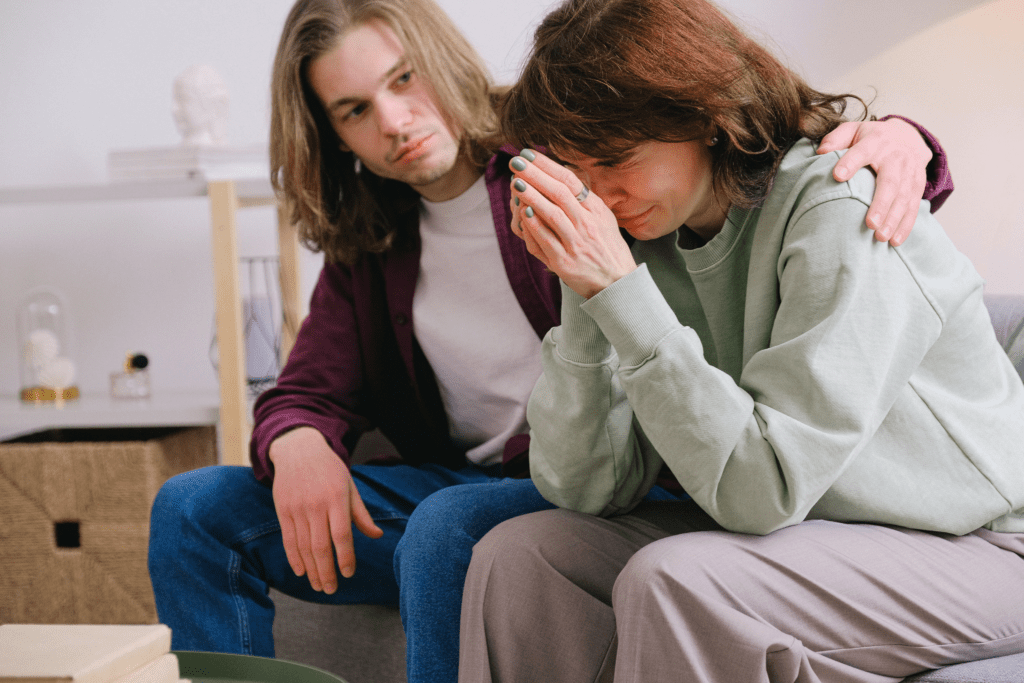Last updated on December 18th, 2024 at 03:20 am
- 1. Understanding Schizoaffective Disorder
- 1.1 Symptoms of Schizoaffective Disorder
- 1.2 Types of Schizoaffective Disorder
- 2. Exploring Bipolar Disorder
- 2.1 Types of Bipolar Disorder
- 2.2 Symptoms of Bipolar Disorder
- 3. Comparing Schizoaffective Disorder and Bipolar Disorder
- 3.1 Similarities
- 3.2 Key Differences
- 4. Diagnosis and Assessment
- 4.1 Diagnostic Criteria
- 4.2 Diagnostic Challenges
- 5. Treatment Approaches
- 5.1 Medication
- 5.2 Psychotherapy
- 6. Living with Schizoaffective or Bipolar Disorder
- 7. Impact on Society and Healthcare Systems
- 8. Research and Future Directions
- 9. Stigma and Awareness
- 10. Environmental and Genetic Risk Factors
- 11. Brain Chemistry and Function
- 12. Electroconvulsive Therapy (ECT) for Severe Symptoms
- 13. Schizoaffective Disorder and Crisis Management
- 14. Social Life and Isolation
- 15. Substance Misuse and Co-occurring Disorders
- 16. Family Therapy and Support
- 17. Mood Symptoms and Antipsychotic Drugs
- 18. Psychotherapy for Better Outcomes
- 19. Impact of Schizoaffective Disorder on Daily Living
- 20. Schizoaffective Disorder and Employment Support
- 21. Schizoaffective Disorder and Legal Considerations
- 22. Bipolar Disorder and Financial Planning
- 23. Schizoaffective Disorder and Relapse Prevention
- 24. Bipolar Disorder and Lifestyle Changes
- 25. Schizophrenia and Medication Adherence
- 26. Schizoaffective Disorder and Community Mental Resources
- 27. Bipolar Disorder and Creative Therapies
- 28. Schizophrenia and Independent Living Skills
- 29. Schizoaffective Disorder and Crisis Intervention
- 30. Bipolar Disorder and Seasonal Patterns
- 31. Schizophrenia and Occupational Therapy
- Conclusion
- Frequently Asked Questions
- What Are The Differences Between Schizoaffective And Bipolar Disorder?
- What Are The Risk Factors For Developing Schizoaffective Disorder?
- How Do Mood Symptoms Differ In Schizoaffective And Bipolar Disorders?
- How Does Family History Influence The Development Of Bipolar Disorder?
- What Are The Common Symptoms Of Schizoaffective Disorder?
- What Is The Role Of Antipsychotic Medications In Treating Schizoaffective Disorder?
- How Does Schizoaffective Disorder Affect Daily Routine And Functioning?
- What Are Negative Symptoms In Schizoaffective Disorder?
- What Treatment Options Are Available For Schizoaffective Disorder?
- What Are The Symptoms Of Mania In Bipolar Disorder?
- How Is The Diagnosis Of Schizoaffective Disorder Made?
- What Role Does Cognitive Behavioral Therapy Play In Managing Schizoaffective Disorder?
- How Does Substance Misuse Impact Individuals With Bipolar Disorder?
- What Are Schizoaffective Disorder Prognosis And Long-Term Outcomes?
- What Is The Importance Of Family Therapy In Schizoaffective Disorder Treatment?
- How Do Antipsychotic Medications Help Manage Schizoaffective Disorder Symptoms?
- How Does Schizoaffective Disorder Affect Social Relationships?
- What Are The Early Warning Signs Of Schizophrenia Spectrum Disorders?
- How Does Electroconvulsive Therapy Work For Schizoaffective Disorder?
- What Lifestyle Changes Can Help Manage Bipolar Disorder Symptoms?
Mental health disorders can be complex and often misunderstood, particularly when it comes to conditions that share similar symptoms. Schizoaffective disorder and bipolar disorder are two such conditions that, while distinct, have overlapping characteristics that can make diagnosis challenging.
This comprehensive exploration delves into the intricacies of these disorders, their similarities and differences, and the impact they have on individuals and society at large.
Schizoaffective and bipolar disorder share overlapping symptoms but differ significantly. Discover their differences, diagnosis, and effective treatment options.
1. Understanding Schizoaffective Disorder
Schizoaffective disorder is a mental health condition that combines features of both schizophrenia and mood disorders. It is characterized by a combination of psychotic symptoms and mood disturbances, making it a unique and often misdiagnosed condition.
1.1 Symptoms of Schizoaffective Disorder
The symptoms of schizoaffective disorder can be broadly categorized into two main groups:
- Psychotic symptoms: These include hallucinations, delusions, and disorganized thinking.
- Mood symptoms: These can be either manic episodes (as in bipolar disorder) or depressive episodes.
Individuals with schizoaffective disorder may experience these symptoms simultaneously or at different times, leading to significant impairment in daily functioning.
1.2 Types of Schizoaffective Disorder
Schizoaffective disorder is typically classified into two subtypes:
- Bipolar type: Characterized by manic episodes, often with depressive episodes as well.
- Depressive type: Involves only major depressive episodes without mania.
Understanding these subtypes is crucial for accurate diagnosis and effective treatment planning.
2. Exploring Bipolar Disorder
Bipolar disorder, formerly known as manic-depressive illness, is a mood disorder characterized by alternating periods of extreme highs (mania or hypomania) and lows (depression).
2.1 Types of Bipolar Disorder
There are several recognized types of bipolar disorder:
- Bipolar I Disorder: Defined by manic episodes that last at least seven days or severe manic symptoms requiring immediate hospital care. Depressive episodes typically last at least two weeks.
- Bipolar II Disorder: Characterized by a pattern of depressive episodes and hypomanic episodes, but not full-blown manic episodes.
- Cyclothymic Disorder: Involves periods of hypomanic symptoms and periods of depressive symptoms lasting for at least two years (one year in children and adolescents).
2.2 Symptoms of Bipolar Disorder
The symptoms of bipolar disorder vary depending on whether the individual is experiencing a manic or depressive episode:
- Manic symptoms: Increased energy, reduced need for sleep, racing thoughts, risky behavior, and inflated self-esteem.
- Depressive symptoms: Feelings of sadness, hopelessness, loss of interest in activities, changes in appetite or sleep patterns, and thoughts of death or suicide.


3. Comparing Schizoaffective Disorder and Bipolar Disorder
While schizoaffective disorder and bipolar disorder share some similarities, they are distinct conditions with important differences.
3.1 Similarities
- Both disorders involve mood disturbances, including manic and depressive episodes.
- Both can significantly impact an individual’s daily functioning and quality of life.
- Both disorders often require long-term management and treatment.
3.2 Key Differences
- Psychotic symptoms: In schizoaffective disorder, psychotic symptoms are present even in the absence of mood episodes. In bipolar disorder, psychotic symptoms, if present, typically occur only during severe mood episodes.
- Duration of symptoms: Schizoaffective disorder requires the presence of psychotic symptoms for at least two weeks in the absence of a major mood episode. Bipolar disorder does not have this requirement.
- Cognitive impairment: Individuals with schizoaffective disorder often experience more significant cognitive impairment compared to those with bipolar disorder.
4. Diagnosis and Assessment
Accurate diagnosis of schizoaffective disorder and bipolar disorder is crucial for effective treatment but can be challenging due to overlapping symptoms.
4.1 Diagnostic Criteria
Mental health professionals use the criteria outlined in the Diagnostic and Statistical Manual of Mental Disorders (DSM-5) to diagnose these conditions. Key considerations include:
- The presence and duration of psychotic symptoms
- The nature and severity of mood episodes
- The timing of symptoms in relation to mood episodes
- The impact of symptoms on daily functioning
4.2 Diagnostic Challenges
Several factors can complicate the diagnostic process:
- Overlapping symptoms between disorders
- Co-occurring mental health conditions
- Substance use disorders, which can mimic or exacerbate symptoms
- Cultural factors that may influence symptom presentation and interpretation


5. Treatment Approaches
Treatment for both schizoaffective disorder and bipolar disorder typically involves a combination of medication and psychotherapy.
5.1 Medication
Common medications used in the treatment of these disorders include:
- Antipsychotics: To manage psychotic symptoms and mood stabilization
- Mood stabilizers: To help control manic and depressive episodes
- Antidepressants: Sometimes used to treat depressive symptoms, but with caution due to the risk of triggering manic episodes
5.2 Psychotherapy
Various forms of psychotherapy can be beneficial:
- Cognitive Behavioral Therapy (CBT): Helps individuals identify and change negative thought patterns and behaviors
- Family-focused therapy: Involves family members in treatment to improve communication and support
- Interpersonal and social rhythm therapy: Focuses on stabilizing daily routines and improving relationships
6. Living with Schizoaffective or Bipolar Disorder
Managing these conditions requires ongoing effort and support. Key strategies include:
- Adhering to medication regimens
- Attending regular therapy sessions
- Maintaining a stable sleep schedule
- Avoiding substance use
- Building a strong support network
- Developing coping skills for stress management
7. Impact on Society and Healthcare Systems
Schizoaffective disorder and bipolar disorder have significant societal and economic impacts:
- Increased healthcare utilization and costs
- Higher rates of unemployment and disability
- Strain on family and social relationships
- Challenges in providing adequate community support and resources


8. Research and Future Directions
Ongoing research in the field of mental health is shedding new light on these disorders:
- Genetic studies to understand hereditary factors
- Neuroimaging research to explore brain structure and function
- Development of new medications with fewer side effects
- Investigation of novel therapeutic approaches, including transcranial magnetic stimulation and ketamine treatments
9. Stigma and Awareness
Despite increased public awareness, stigma surrounding mental health disorders persists. Efforts to combat stigma include:
- Public education campaigns
- Advocacy for mental health parity in healthcare
- Representation of mental health issues in media and popular culture
- Peer support programs and community initiatives
10. Environmental and Genetic Risk Factors
The development of schizoaffective disorder and bipolar disorder can be influenced by a wide range of environmental factors and genetic predispositions. A family history of mental illnesses such as schizophrenia spectrum disorders or bipolar disorder can increase the likelihood of developing these conditions.
Additionally, early exposure to trauma or substance misuse can significantly heighten the risk factors for developing symptoms. Understanding these risk contributors is crucial for establishing a treatment plan that takes into account personal history and environmental influences.
11. Brain Chemistry and Function
Research into brain chemistry reveals that changes in neurotransmitter levels may contribute to schizoaffective disorder symptoms and bipolar disorder symptoms and management. Alterations in brain function are often identified through brain imaging technologies, highlighting abnormalities in white matter or neurotransmitter pathways.
These severe symptoms can result from an imbalance in brain chemicals, affecting mood symptoms and contributing to psychotic episode presentations. Understanding these biological markers aids clinicians in forming a correct diagnosis and selecting the appropriate type of medicine used.


12. Electroconvulsive Therapy (ECT) for Severe Symptoms
For those with persistent or severe symptoms unresponsive to other treatments, Electroconvulsive therapy (ECT) can be an effective intervention. ECT involves the application of controlled electric currents to the brain, helping alleviate episodes of mania or major depression.
This option is typically reserved for cases where antipsychotic medications and other treatment options fail to produce significant improvements. It serves as a viable option in clinical practice for individuals with debilitating symptoms.
13. Schizoaffective Disorder and Crisis Management
Schizoaffective disorder treatment often involves having a crisis plan in place to manage psychotic episodes or episodes of depression. Collaboration with a mental health team is essential for creating a safety net, especially in times when episodes of mania or depressive episodes present significant challenges.
Timely interventions in community mental settings and the use of crisis intervention techniques can greatly improve outcomes, ensuring continuity in care. These approaches help prevent symptoms from worsening and minimize potential risks.
14. Social Life and Isolation
Social isolation is a common issue for individuals living with schizoaffective disorder or bipolar disorder due to mood disorder symptoms and episodes of disordered thinking. Such isolation impacts daily living and social life, hindering recovery.
Engaging in community-based peer support programs and structured day activities can help individuals reconnect with their communities. These interactions can reduce the burden of loneliness, facilitating a better quality of life.
15. Substance Misuse and Co-occurring Disorders
Many individuals with schizoaffective disorder or bipolar disorder experience co-occurring substance use disorders, which complicate the treatment process. The misuse of mind-altering drugs can exacerbate schizoaffective disorder symptoms and increase symptoms of psychosis.
Implementing a dual diagnosis treatment approach that simultaneously addresses substance abuse and underlying psychiatric disorder can be highly effective. This approach is known to reduce relapse rates and promote better mental health outcomes.
16. Family Therapy and Support
Incorporating family therapy as part of a comprehensive treatment plan is particularly beneficial for individuals diagnosed with schizoaffective disorder or bipolar disorder. Engaging family members in therapy helps improve understanding of mood disorder with psychotic features and teaches coping mechanisms that support recovery.
Family involvement also aids in fostering a stable home environment and mitigating triggers that might lead to future episodes. This support is crucial in reducing stress and enhancing treatment outcomes.


17. Mood Symptoms and Antipsychotic Drugs
Managing mood symptoms in schizoaffective and disorder bipolar often requires the use of antipsychotic drugs and mood stabilizers. These psychiatric medications are designed to address episodes of psychosis, while also mitigating manic mood or depressive disorder symptoms.
Long-term medication management under the guidance of a healthcare provider can help achieve treatment compliance. It also helps in minimizing the occurrence of persistent symptoms that interfere with daily functioning.
18. Psychotherapy for Better Outcomes
Schizoaffective disorder psychotherapy approaches like Cognitive Behavioral Therapy (CBT) and life skills training focus on teaching individuals how to manage negative symptoms and enhance their daily activities. These psychotherapy sessions emphasize identifying distorted thoughts and understanding schizophrenia cognitive symptoms.
Implementing emotional regulation skills during these sessions promotes resilience. Psychoeducation programs for both patients and their families also form a critical part of the recovery process.
19. Impact of Schizoaffective Disorder on Daily Living
Schizoaffective disorder and bipolar disorder significantly affect an individual’s ability to perform daily living tasks and participate in everyday activities. The presence of schizophrenia positive symptoms and episodes of hypomania can result in disorganized behavior and confused thinking.
This hinders effective daily routine management and necessitates intervention. Strategies such as maintaining a consistent daily routine, attending community mental services, and undergoing life skills training are essential for enhancing functionality.
20. Schizoaffective Disorder and Employment Support
Maintaining employment is a significant challenge for those diagnosed with schizoaffective disorder or bipolar disorder, as schizophrenia symptoms and mood disruptions impact workplace performance. Community resources and employment support programs can assist individuals by providing disability accommodations.
These programs help manage daily life demands and encourage a stable work-life balance. Empowerment through structured support not only improves occupational engagement but also fosters long-term stability in daily activities.


21. Schizoaffective Disorder and Legal Considerations
Individuals diagnosed with schizoaffective disorder or bipolar disorder may face unique legal considerations due to the unpredictability of psychotic features and mood disorder symptoms. Navigating the legal system requires specialized knowledge to protect patients’ rights, especially during a psychotic episode.
Access to community mental resources and legal aid can assist in ensuring that individuals receive fair treatment. Such support is crucial for accessing the necessary healthcare and avoiding legal challenges.
22. Bipolar Disorder and Financial Planning
Living with bipolar disorder can lead to challenges in managing finances due to extreme shifts in mood, including impulsive behavior during episodes of mania. Structured financial planning and support from a healthcare provider can help individuals stabilize their economic situation.
A consistent daily routine and life skills training may also prevent financial disruptions and improve overall quality of life. Proactive measures are important for ensuring a stable future.
23. Schizoaffective Disorder and Relapse Prevention
Schizoaffective disorder often requires strategies for relapse prevention to maintain stability in daily activities. The use of atypical antipsychotic medications, combined with mindfulness practices, can mitigate the likelihood of future episodes.
A comprehensive treatment plan also incorporates cognitive therapy to identify triggers and implement coping skills for stress and emotional regulation. This holistic approach helps individuals maintain long-term stability.
24. Bipolar Disorder and Lifestyle Changes
Bipolar disorder management benefits greatly from consistent lifestyle changes such as regular exercise benefits, proper dietary considerations, and structured daily living habits. Bipolar disorder mood stabilizers play an essential role in maintaining balance, while a focus on mental health coping strategies helps ensure long-term stability.
Incorporating mindfulness practices and structured day activities can also support emotional wellness. These lifestyle modifications contribute to improved resilience and functioning.
25. Schizophrenia and Medication Adherence
For individuals with schizophrenia, medication adherence is vital to managing positive symptoms and negative symptoms effectively. A treatment plan that includes consistent monitoring by a mental health team helps ensure proper medication management.
Addressing factors such as substance misuse or other medical illnesses can also contribute to better adherence. Improving adherence is key to a successful recovery journey.
26. Schizoaffective Disorder and Community Mental Resources
Access to community mental health services is crucial for individuals living with schizoaffective disorder. Community resources offer support through peer support groups, employment support, and day activities that foster independence.
Leveraging peer relationships and involvement in supportive therapy can help mitigate social withdrawal and improve overall mental health outcomes. Participation in community activities promotes recovery and a sense of belonging.


27. Bipolar Disorder and Creative Therapies
Bipolar disorder often benefits from creative therapies such as art, music, or writing, which can help manage bipolar symptoms and enhance emotional expression. Creative outlets provide a safe space for exploring emotions experienced during manic mood or depressive episodes.
These therapies, when combined with traditional psychiatric medications, provide a holistic approach to managing symptoms. Creative expression helps in improving mood and overall mental health.
28. Schizophrenia and Independent Living Skills
Teaching independent living skills is an essential part of treatment for individuals with schizophrenia. These skills are crucial for managing everyday activities and maintaining a structured daily routine.
Techniques like skills training and adaptive coping skills focus on improving daily living and fostering independence. This approach reduces the reliance on caregivers and promotes self-sufficiency.
29. Schizoaffective Disorder and Crisis Intervention
Effective crisis intervention is essential for managing episodes of psychosis in schizoaffective disorder. Working with community clinicians and employing techniques such as crisis management and therapeutic interventions can de-escalate situations.
These approaches minimize harm and provide necessary support during acute distress. Developing a crisis plan as part of the treatment plan can offer structure and security in times of need.
30. Bipolar Disorder and Seasonal Patterns
For many individuals with bipolar disorder, symptoms can be influenced by seasonal patterns. Changes in daylight hours may contribute to fluctuations in mood symptoms, triggering episodes of mania or episodes of depression.
Recognizing these patterns is crucial for preparing a treatment plan that includes preventive strategies, such as light therapy or emotional regulation skills. Early identification helps in reducing symptom severity.
31. Schizophrenia and Occupational Therapy
Occupational therapy plays a key role in managing schizophrenia symptoms and improving social functioning. This form of therapy helps individuals regain skills necessary for completing everyday activities and reentering the workforce.
Focused interventions on life skills training and adaptive coping skills provide the support needed for a successful reintegration. Occupational engagement fosters independence and enhances community participation.
Conclusion
Schizoaffective disorder and bipolar disorder are complex mental health conditions that require careful diagnosis and comprehensive treatment. While they share some similarities, understanding their distinct features is crucial for effective management.
As research continues to advance our understanding of these disorders, there is hope for improved treatments and outcomes for individuals affected by these conditions. By fostering greater awareness and reducing stigma, society can create a more supportive environment for those living with mental health challenges.
From Embrace Inner Chaos to your inbox
Transform your Chaos into authentic personal growth – sign up for our free weekly newsletter! Stay informed on the latest research advancements covering:
Narcissistic Personality Disorder (NPD)
Frequently Asked Questions
What Are The Differences Between Schizoaffective And Bipolar Disorder?
Schizoaffective disorder and bipolar disorder share overlapping symptoms, such as mood swings and psychosis, which can make distinguishing between the two challenging. However, schizoaffective disorder includes symptoms of both schizophrenia and a mood disorder, typically occurring concurrently or separately over a prolonged period.
Bipolar disorder, on the other hand, is characterized primarily by extreme mood swings, ranging from manic episodes to depressive episodes. According to Mayo Clinic, bipolar disorder may occasionally have psychotic symptoms, but these are linked specifically to mood episodes, unlike the persistent psychotic features found in schizoaffective disorder.
What Are The Risk Factors For Developing Schizoaffective Disorder?
Several risk factors contribute to the development of schizoaffective disorder. Genetic predisposition plays a major role, especially if there is a family history of mental illnesses like schizophrenia or bipolar disorder.
Environmental factors, such as exposure to stress, trauma, or drug misuse, can also trigger or worsen symptoms. According to Cleveland Clinic, abnormal brain chemistry and structure may also influence the onset of schizoaffective disorder.


How Do Mood Symptoms Differ In Schizoaffective And Bipolar Disorders?
Mood symptoms in schizoaffective disorder can include both manic and depressive features that exist alongside schizophrenia symptoms like hallucinations and delusions. In bipolar disorder, mood symptoms primarily involve extreme shifts between episodes of mania and episodes of depression.
According to WebMD, schizoaffective patients may experience these mood symptoms more persistently along with psychotic features, whereas bipolar individuals exhibit mood episodes in a more episodic manner without continuous psychotic symptoms. Proper identification of mood symptoms is essential for effective treatment planning.
How Does Family History Influence The Development Of Bipolar Disorder?
Family history is one of the strongest predictors of developing bipolar disorder. Studies show that individuals with first-degree relatives, such as parents or siblings, who have bipolar disorder have a significantly higher risk of developing the condition themselves.
The National Institute of Mental Health (NIMH) notes that genetic factors, particularly when combined with environmental triggers, can make someone more susceptible to bipolar disorder. It is crucial for individuals with a family history to monitor early symptoms for timely diagnosis and intervention.
What Are The Common Symptoms Of Schizoaffective Disorder?
Schizoaffective disorder presents a unique combination of schizophrenia symptoms and mood disorder symptoms. These include hallucinations, delusions, disorganized behavior, along with episodes of mania or major depression.
As explained by Johns Hopkins Medicine, individuals may experience psychotic symptoms without mood episodes, making it distinct from bipolar disorder. Symptoms like disordered thinking and social withdrawal also add to the complexity of the diagnosis.
What Is The Role Of Antipsychotic Medications In Treating Schizoaffective Disorder?
Antipsychotic medications are a cornerstone of schizoaffective disorder treatment, helping to manage psychotic symptoms such as hallucinations and delusions. According to American Psychiatric Association, antipsychotic drugs are often used in combination with mood stabilizers or antidepressants to control both psychotic and mood disorder symptoms.
These medications help individuals function better in daily activities by reducing the severity of symptoms. However, medical professionals closely monitor their use due to potential side effects and the need for adjustments based on response.
How Does Schizoaffective Disorder Affect Daily Routine And Functioning?
Schizoaffective disorder can severely impact a person’s ability to perform everyday activities. Symptoms like disorganized behavior, confusion, and episodes of mania or depression interfere with maintaining a consistent daily routine.
According to Everyday Health, individuals with schizoaffective disorder may struggle with social isolation, impaired work performance, and challenges in self-care. Treatment plans often include a combination of medication, psychotherapy, and lifestyle interventions.
What Are Negative Symptoms In Schizoaffective Disorder?
Negative symptoms refer to a reduction or absence of normal functions, such as social interaction, emotional expression, and motivation. In schizoaffective disorder, these symptoms include blunted affect, reduced speech output, and lack of motivation.
National Alliance on Mental Illness (NAMI) states that negative symptoms can make it difficult for individuals to engage in social activities and manage personal responsibilities. These symptoms can often be more disabling than the positive symptoms.
What Treatment Options Are Available For Schizoaffective Disorder?
Treatment for schizoaffective disorder typically includes a combination of antipsychotic medications, mood stabilizers, and psychotherapy. Psychosocial interventions such as family therapy and skills training are also effective in improving social functioning.
According to Mental Health America, electroconvulsive therapy (ECT) may be used in severe cases where other treatments are not effective. A comprehensive treatment plan that includes medication, therapy, and lifestyle changes can help individuals manage symptoms.
What Are The Symptoms Of Mania In Bipolar Disorder?
Symptoms of mania in bipolar disorder include elevated mood, increased energy, racing thoughts, and sometimes impulsive or reckless behavior. During a manic episode, individuals may experience decreased need for sleep and heightened irritability.
Harvard Medical School highlights that symptoms of mania can impair social relationships, work performance, and daily functioning. Identifying these symptoms early can prevent escalation and facilitate intervention.
How Is The Diagnosis Of Schizoaffective Disorder Made?
The diagnosis of schizoaffective disorder requires a careful evaluation of both mood symptoms and psychotic features. Healthcare professionals conduct a detailed psychiatric assessment, medical history review, and often blood tests to rule out other medical conditions.
According to the American Psychological Association, the DSM-5 criteria require that a major mood episode be present for the majority of the illness along with periods of psychosis. Accurate diagnosis is challenging due to the overlap with other disorders.


What Role Does Cognitive Behavioral Therapy Play In Managing Schizoaffective Disorder?
Cognitive Behavioral Therapy (CBT) is an effective approach for managing symptoms of schizoaffective disorder, particularly in addressing negative thought patterns and improving coping strategies. Psychology Today reports that CBT helps individuals better understand their thoughts and emotions, thereby reducing the distress caused by hallucinations or delusions.
CBT also aids in managing mood disorder symptoms, allowing individuals to gain better control over their emotions and reactions. This therapy can significantly enhance quality of life.
How Does Substance Misuse Impact Individuals With Bipolar Disorder?
Substance misuse is a common comorbidity among individuals with bipolar disorder, often exacerbating symptoms and complicating treatment. Substance use can trigger episodes of mania or depression, leading to worse outcomes.
National Institute on Drug Abuse (NIDA) emphasizes that co-occurring substance use disorders require integrated treatment approaches to address both the mood disorder and the substance misuse. This dual treatment approach is crucial in preventing relapse.
What Are Schizoaffective Disorder Prognosis And Long-Term Outcomes?
The prognosis for schizoaffective disorder varies depending on early diagnosis, treatment adherence, and social support. With a comprehensive treatment plan, individuals can experience significant symptom reduction and improved quality of life.
According to Verywell Mind, long-term outcomes are better for those who receive consistent psychiatric care and psychosocial support. Factors such as medication adherence, family involvement, and reduced stress levels are essential for better outcomes.
What Is The Importance Of Family Therapy In Schizoaffective Disorder Treatment?
Family therapy plays a crucial role in treating schizoaffective disorder by providing education, support, and strategies to improve communication and reduce stress within the family unit. Stanford Medicine highlights that involving family members in the treatment process helps in reducing relapse rates and improving overall patient outcomes.
Family therapy sessions often focus on setting realistic expectations, understanding symptoms, and learning coping mechanisms that enhance the home environment. Family involvement is key to patient stability.
How Do Antipsychotic Medications Help Manage Schizoaffective Disorder Symptoms?
Antipsychotic medications are essential in managing both the psychotic and mood disorder symptoms in schizoaffective disorder. They help alleviate hallucinations, delusions, and disordered thinking.
According to WebMD, these medications are often combined with mood stabilizers or antidepressants to treat the full range of symptoms. Monitoring and adjusting medication dosages are important to maximize symptom control.
How Does Schizoaffective Disorder Affect Social Relationships?
Individuals with schizoaffective disorder often face significant challenges in maintaining social relationships. Symptoms like hallucinations, delusions, mood instability, and social withdrawal can lead to misunderstandings, isolation, and strained interactions.
Mental Health Foundation notes that effective management of symptoms through medication and therapy can improve social skills and relationships. Engaging in group therapy or support groups also helps individuals rebuild trust.
What Are The Early Warning Signs Of Schizophrenia Spectrum Disorders?
Early warning signs of schizophrenia spectrum disorders, including schizoaffective disorder, often include subtle changes in mood, cognition, and behavior. These signs may include social withdrawal, confused thinking, reduced interest in activities, and unusual perceptual experiences.
National Health Service (NHS) advises that recognizing these early symptoms can lead to prompt intervention. Early treatment can mitigate the severity of symptoms and improve long-term outcomes.
How Does Electroconvulsive Therapy Work For Schizoaffective Disorder?
Electroconvulsive therapy (ECT) is used in severe cases of schizoaffective disorder, especially when medication and psychotherapy have been ineffective. ECT involves passing small electric currents through the brain to trigger a controlled seizure, which helps reset abnormal brain activity.
According to Mayo Clinic, ECT is most often used to alleviate severe symptoms of depression or episodes of mania that do not respond to other treatments. Despite its effectiveness, ECT is usually considered a last resort.
What Lifestyle Changes Can Help Manage Bipolar Disorder Symptoms?
Lifestyle changes play an important role in managing bipolar disorder symptoms. Maintaining a regular daily routine, avoiding mind-altering substances, and engaging in regular physical exercise can stabilize mood swings.
According to Harvard Health Publishing, individuals are encouraged to establish consistent sleep patterns and follow a balanced diet. Integrating mindfulness practices, stress management techniques, and social support also helps in reducing the risk of triggering future episodes.




